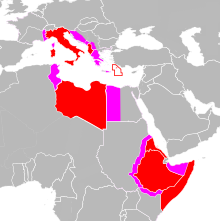Italian Tunisians

Flag of Italy (1861-1946)
|
|

Italian Imperial territories and settlements in Africa
|
|
| Total population | |
|---|---|
| (3,000 (by birth, 2006)) | |
| Regions with significant populations | |
| Tabarka, La Goulette, Tunis | |
| Languages | |
| French, Italian, Tunisian Arabic, Sicilian, Neapolitan, other Italian dialects | |
| Religion | |
| Roman Catholicism |
Italian Tunisians (or Italians of Tunisia) are Tunisians of Italian descent. Migration and colonization, particularly during the 19th century, led to significant numbers of Italians settling in Tunisia.
The presence of a numerous community of Italians in Tunisia has ancient origins, but it is only from the first half of the 19th century that its economic and social weight became critical in many fields of the social life of the country.
The Republic of Genoa occupied the island of Tabarka near Biserta, where the Genoese family Lomellini, who had purchased the grant of the coral fishing from the Ottoman Turks, maintained a garrison from 1540 to 1742. Here may still be seen the ruins of a stronghold, a church and some Genoese buildings. At Tabarka the ruins consist of a pit once used as a church and some fragments of walls which belonged to Christian buildings.
Italian Jews from Livorno created the first foreign community in Tunisia, after the 16th century. In those centuries, the Italian language became the lingua franca in the field of the commerce in the Maghreb.
After the 1848 revolutions many Italian patriots sought refuge in Tunis; among them were Giuseppe Morpurgo and Pompeo Sulema, from Leghorn (even Garibaldi had called at Tunis in 1834 to advise Bey Hussein on the administration of a modern navy; he came back in 1849 and was hosted at Palazzo Gnecco, Rue de l'Ancienne Douane.) Among the exiled was Gustavo Modena, who earned his living by teaching Italian to the Tunisian gentry 'smerciando participi' (peddling participles, in his own inventive expression.) Sulema opened a regular school that was soon patronized by the Jewish minority, both local and from Leghorn, as it was not a confessional one, while the other Italians preferred to follow the Rotonda and Visconti school. Another Italian school was opened in 1845 by Morpurgo, Luisada and Salone, joined later by Sulema, and was closed in 1863.
Trading houses of the regency in this period were mostly Italian (Bensasson, Fiorentino, Gutierrez, Moreno, Peluffo, Sonnino.) On 4 January 1874 the Italian community, headed by the Consul, opened an elementary school that was partly funded by the state: on opening it had 73 pupils, half of them from the Jewish community. The secretary of state of the Bey, today we would say the prime minister of the time, was often an Italian. In 1859 the trade convention between the Bey of Tunis and the consul general of Austria, Giovanni Gasparo Merlato, had been written in Italian; that is no wonder, since in the Austrian Empire as a federal entity, the official language for the Navy and most of the trade was Italian. Around the start of the 20th century there was also an Italian newspaper in Tunis, called L'Unione, which clamored for annexation of the territory; but France was gradually taking hold and, after 1902, foreign lawyers (most of whom were Italian nationals) could not practice unless they had a French degree, and the license from the Italian High School in Tunis was not adequate to gain access to a French university.
...
Wikipedia
